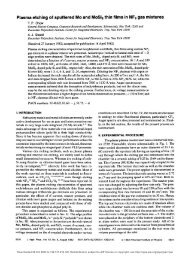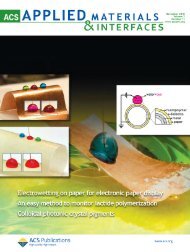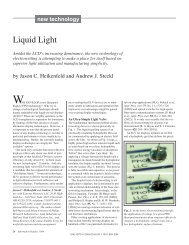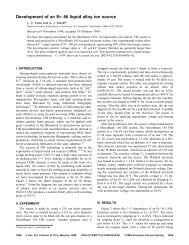Circuits on Cellulose - University of Cincinnati
Circuits on Cellulose - University of Cincinnati
Circuits on Cellulose - University of Cincinnati
You also want an ePaper? Increase the reach of your titles
YUMPU automatically turns print PDFs into web optimized ePapers that Google loves.
Top: Duk-Young Kim/Andrew J. Steckl/<strong>University</strong> <strong>of</strong> <strong>Cincinnati</strong>; Bottom: Jin-Young Kim/sungkyungkwan university<br />
or developing the right kinds <strong>of</strong> paper. The best<br />
are those that have special polymer coatings<br />
that help fill in troughs in the surface and seal<br />
the paper to prevent chemical degradati<strong>on</strong> during<br />
the fabricati<strong>on</strong> process.<br />
Paper would simply combust at the temperatures<br />
used to grow and treat the crystalline films<br />
used in traditi<strong>on</strong>al semic<strong>on</strong>ductors, so inorganic<br />
paper-based transistors are typically made from<br />
amorphous, n<strong>on</strong>crystalline films. These can be<br />
formed at a lower temperature using the standard<br />
techniques <strong>of</strong> depositing a material in a<br />
vacuum, such as evaporati<strong>on</strong> or sputtering. This<br />
fabricati<strong>on</strong> strategy is straightforward, but the<br />
resulting transistors tend to embrace paper’s<br />
inherent textural variati<strong>on</strong>, the result being that<br />
the voltage needed to get current to flow in them<br />
can be a dozen times as much as what’s needed<br />
to move electr<strong>on</strong>s through transistors built <strong>on</strong><br />
glass or silic<strong>on</strong>. John Rogers’s group at the<br />
<strong>University</strong> <strong>of</strong> Illinois at Urbana-Champaign, for<br />
example, has been perfecting an alternative approach<br />
in which circuits are built <strong>on</strong> silic<strong>on</strong> and<br />
then transferred to paper (or other substrates)<br />
<strong>on</strong>ce they’re finished. This method tends to create<br />
better-performing circuits, although the fabricati<strong>on</strong><br />
process is c<strong>on</strong>siderably more involved,<br />
and it’s also more costly, because it would start<br />
with a silic<strong>on</strong> wafer.<br />
When it comes to mass producti<strong>on</strong>, however,<br />
the organic semic<strong>on</strong>ductors may be the way to<br />
go. Unlike inorganic materials, organic compounds<br />
can be dissolved in fluid and deposited<br />
<strong>on</strong> paper using roll-to-roll printers, just as with<br />
ordinary ink. But this approach still faces some<br />
obstacles. For <strong>on</strong>e, the transistors tend to be<br />
slower, due to the intrinsic properties <strong>of</strong> organic<br />
semic<strong>on</strong>ductors. And organic switches are naturally<br />
more sensitive to envir<strong>on</strong>mental c<strong>on</strong>diti<strong>on</strong>s.<br />
Oxygen and water vapor, for example,<br />
can degrade or even open up a gap between<br />
an organic material and a metal electrode<br />
through chemical degradati<strong>on</strong> by oxidati<strong>on</strong> or<br />
by partially dissolving the structure. Surface<br />
treatments can help make paper—which naturally<br />
sops up moisture from the air that could<br />
affect the device built <strong>on</strong> top— relatively impermeable.<br />
But a fix is still needed to ensure that<br />
organic circuits perform well over l<strong>on</strong>g periods<br />
in relatively humid envir<strong>on</strong>ments.<br />
P i xe l s<br />
Thin-film circuits built <strong>on</strong> paper are too slow to be c<strong>on</strong>sidered for general<br />
purpose computing, but they are an attractive means for c<strong>on</strong>trolling and interacting<br />
with “outward-facing” devices such as sensors, displays, and energy-harvesting gear.<br />
Building such devices <strong>on</strong> paper can be just as challenging as building back-end electr<strong>on</strong>ics.<br />
But there has been a lot <strong>of</strong> progress, particularly in the relatively inexpensive and<br />
low-power realm <strong>of</strong> reflective displays. One promising approach is the electrochromic<br />
display, which uses pixels made <strong>of</strong> a c<strong>on</strong>ducting polymer. If a sufficient voltage is applied<br />
to such a pixel, electr<strong>on</strong>s will be knocked <strong>of</strong>f and the optical properties <strong>of</strong> the polymer will<br />
change, turning it from, say, dark blue to transparent. This approach, which was pi<strong>on</strong>eered<br />
by Magnus Berggren’s group at Linköping <strong>University</strong>, in Sweden, has many advantages.<br />
For <strong>on</strong>e, it requires just a few volts to operate, and it’s structurally fairly simple. But there<br />
are a few drawbacks. The color palette is limited, and the switching speed is quite slow.<br />
It can take anywhere from a fracti<strong>on</strong> <strong>of</strong> a sec<strong>on</strong>d to several sec<strong>on</strong>ds to complete pixel<br />
transformati<strong>on</strong>, which makes the display unsuitable for full-moti<strong>on</strong> video.<br />
At the <strong>University</strong> <strong>of</strong> <strong>Cincinnati</strong>, my group has been working <strong>on</strong> adapting an alternative<br />
display approach called electrowetting, which is traditi<strong>on</strong>ally used with glass. Electrowetting<br />
works by c<strong>on</strong>fining liquids between two surfaces and then altering their surface<br />
tensi<strong>on</strong>, using an applied voltage. Altering the surface tensi<strong>on</strong> causes the colored liquid<br />
to either spread out and reflect light or<br />
ball up and allow the light through. Paper<br />
hardly seems a natural fit for this technique.<br />
Electrowetting displays typically<br />
use liquids like water and oil that are<br />
readily absorbed by paper. Pixels also<br />
need to be built <strong>on</strong> a very smooth, glasslike<br />
surface to ensure reliability and fast<br />
resp<strong>on</strong>se. With a rough surface, it’s very<br />
hard to guarantee that liquids will move<br />
where they’re supposed to every time.<br />
We first tried the same sort <strong>of</strong> waxcoated<br />
papers that you might find in your<br />
kitchen cupboard, standard “smoothfinish”<br />
commercial papers, and also<br />
a translucent paper called glassine.<br />
Although the surfaces <strong>of</strong> all these paper<br />
<strong>on</strong> display: Paper can be used<br />
to make displays that either reflect<br />
incoming light or emit their own.<br />
One way to make a reflective display<br />
is to alter the surface tensi<strong>on</strong> <strong>of</strong> liquid<br />
pixels [top]. Organic light-emitting<br />
diodes can also be built <strong>on</strong> paper to<br />
make displays that glow [bottom].<br />
SPECTRUM.IEEE.ORG | North American | FEB 2013 | 51








